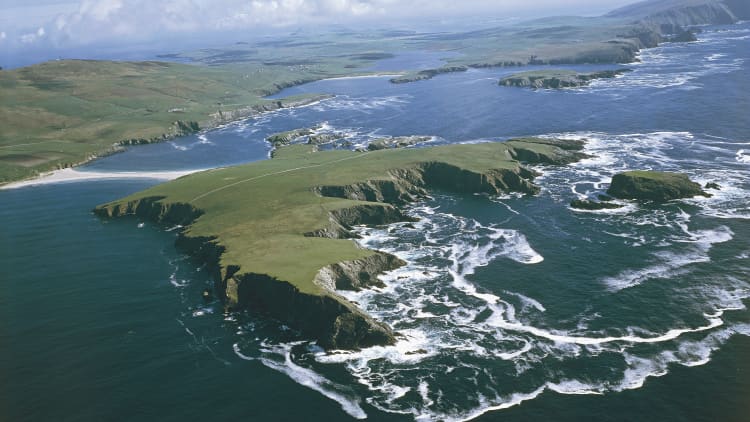A Haliade-X wind turbine photographed in the Netherlands on March 2, 2022.
Peter Boer | Bloomberg | Getty Images
A project described as the “world’s largest offshore wind farm” took a major step forward over the weekend after producing its first power.
Located off the coast of northeast England in the North Sea, the Dogger Bank Wind Farm is being developed in three phases — A, B and C — and will have a total capacity of 3.6 gigawatts once fully up and running. A fourth phase, known as Dogger Bank D, has been proposed.
“The project’s first turbine at Dogger Bank A started turning and producing electricity at 8.37pm BST on Saturday 7 October,” the Dogger Bank Wind Farm Project said in an announcement Monday.
“Power from the first offshore wind turbine is now being transmitted to the UK’s national grid via Dogger Bank’s high-voltage direct current … transmission system, marking the first-time use of HVDC technology on a UK wind farm,” it added.
The scale of the project is considerable, with those behind it saying it will be able to power as many as 6 million homes per year. Dogger Bank is using GE Vernova’s huge Haliade-X turbines, which boast blades measuring 107 meters, or about 351 feet.
Dogger Bank is a joint venture partnership involving SSE Renewables, Equinor and Vårgrønn, which hold stakes of 40%, 40% and 20% respectively.
In a statement, SSE Chief Executive Alistair Phillips-Davies said Dogger Bank would “provide a significant boost to UK energy security, affordability and leadership in tackling climate change.”
“This is exactly how we should be responding to the energy crisis,” he added.
Equinor is a Norwegian business better known for its production of oil and gas, but it also is involved in wind energy projects like Dogger Bank and Hywind Tampen.
“A renewable mega-project like Dogger Bank constitutes an industrial wind hub in the heart of the North Sea, playing a major role in the UK’s ambitions for offshore wind and supporting its net zero ambitions,” Equinor CEO Anders Opedal said.
U.K. Prime Minister Rishi Sunak welcomed the news. Sunak — who has faced sharp criticism from some quarters after a shift in climate policy — described offshore wind as being “critical to generating renewable, efficient energy that can power British homes from British seas.”
The United Kingdom is home to a mature offshore wind sector, with the U.S. government’s International Trade Administration highlighting traits such as good wind speed, a long coastline and a “relatively shallow seabed,” among other things.
Major offshore wind farms in waters off the U.K. include Hornsea 2, a fully operational, 165-turbine facility that boasts a capacity of more than 1.3 GW. Danish energy firm Orsted has previously called it “the world’s largest installed windfarm.”
While those involved in Dogger Bank have repeatedly called it “the world’s largest offshore wind farm,” Monday’s statement also referred to it as the “world’s largest offshore wind farm under construction,” an apparent nod to the fact that significant work is still required before it’s complete.
Across the Atlantic, the U.S. has some way to go to catch up with countries like the U.K., with a range of factors creating a challenging environment for the sector’s development there.
America’s first offshore wind farm, the 30 megawatt Block Island Wind Farm, started commercial operations only in late 2016, although the U.S. is planning to ramp up its offshore wind capacity in the coming years.
In November 2021, ground was broken on Vineyard Wind 1, which has been dubbed the United States’ “first commercial scale offshore wind farm.”

Credit: Source link













